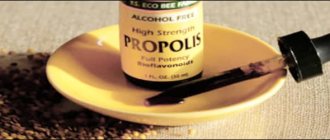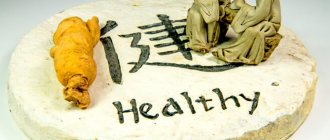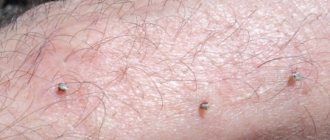Instructions for use of Peony Tincture (Method and dosage)
The instructions for the Tincture of Evading Peony prescribe how to take the medicine. Peony tincture is taken orally 15 minutes before meals. Adults are recommended to take 15-20 drops up to three times a day.
The duration of therapy is determined by a specialist individually for each patient, taking into account the severity, nature and characteristics of the course of the disorder, the confidence of the achieved therapeutic effect and the level of tolerability of the drug.
The recommended duration of treatment is 2 weeks; if necessary, the treatment cycle can be repeated after a 3-month break.
Peony evasive tincture
Registration number: LP-000922
Trade name: Peony evading tincture.
Dosage form: Tincture.
Composition: To obtain the drug the following is used:
- Peony evasive herb – 50 g
- Peony rhizomes and roots - 50 g
- Ethanol (ethyl alcohol) 40% - sufficient amount to obtain 1000 ml
Description: Transparent liquid of light brown color with a specific odor. During storage, sediment may form.
Pharmacotherapeutic group: Sedative of plant origin.
ATX code: N05CM
Pharmacological action: Has a sedative effect on the central nervous system.
Indications for use: Used as a sedative for increased nervous excitability, sleep disorders, neurocirculatory dystonia.
Contraindications: Hypersensitivity to the components of the drug. Liver and/or renal failure, children's age (up to 12 years). Pregnancy, breastfeeding period.
With caution: Alcoholism. Traumatic brain injury, brain diseases. Liver diseases.
Directions for use and dosage: Inside. 30-40 drops per dose 3 times a day for 25 - 30 days. The course of treatment can be repeated after a ten-day break after consultation with a doctor.
Side effects: Allergic reactions are possible.
Use during pregnancy and lactation: The drug contains ethyl alcohol. Not recommended for use during pregnancy and breastfeeding.
Overdose: To date, no cases of overdose have been registered.
Interaction with other drugs: The drug helps to weaken the effect of drugs that tonic the central nervous system. Strengthens the effect of sleeping pills, sedatives and antispasmodics.
Impact on the ability to drive vehicles and operate machinery:
- The maximum single dose of the drug contains 0.4 g of absolute alcohol
- Maximum daily dose – 1.2 g of absolute alcohol
During the treatment period, care must be taken when driving vehicles and engaging in other potentially hazardous activities that require increased concentration and speed of psychomotor reactions.
Release form: 25 ml tincture in an orange glass dropper bottle, sealed with a dropper stopper and a polymer screw cap; 25 ml each in a dropper bottle with a screw neck made of brown glass, sealed with a dropper cap; 25 ml each in an orange glass bottle, sealed with a polymer stopper and a polymer screw cap. Each dropper bottle or bottle, along with instructions for use, is placed in a cardboard pack. Packaging for hospitals: 17 kg bottles, sealed with polymer screw caps and polyethylene gaskets. Each bottle is placed in a polyethylene drum. 4 kg, 8 kg and 17 kg in polyethylene canisters with lids.
Storage conditions: In a place protected from light at a temperature of 15 to 25 ° C. Keep out of the reach of children.
Shelf life: 2 years. Do not use after the expiration date.
Conditions for dispensing from pharmacies: Without a prescription.
Analogs
Level 4 ATC code matches: Alora
Motherwort extract
Novo-Passit
Cardiovalen
Liked
Carmolis
Valerian tincture
Lotusonic
Relaxil
Persen Forte
Persen
Phytosed
Sedavit
Motherwort Forte Evalar
Dormiplant
Sondox
Sedafiton
Menovalen
Bromcamphor
Valerian rhizomes with roots
Hawthorn tincture, Valerian extract, Validispert, Herbion, Dexdor, Doppelgerts Melissa, Karvelis, Cardiopasit, Nevrosal, Motherwort extract, Sanason, Phytosed and others.
Peony tincture is a cure for many diseases
In pursuit of novelty in treatment, doctors often forget old, proven medications. However, over time, it often turns out that it is the old forgotten drugs that are actually better than many modern drugs.
One of these undeservedly forgotten medicines is tincture of Evading Peony .
So, what is good about this tincture? It has a calming effect on the central nervous system, increases the body's resistance to oxygen deficiency, and has antispasmodic and anticonvulsant effects.
Peony tincture treats many diseases:
Firstly, peony tincture helps improve falling asleep and sleep quality in case of insomnia.
It can also help with certain types of arrhythmia - or if the heart rate is increased.
Peony tincture helps reduce high blood pressure due to hypertension, and sometimes does it very effectively! Some patients with hypertension who start using peony tincture even manage to stop taking numerous daily high blood pressure pills over time.
Peony tincture helps very well with the notorious vegetative-vascular dystonia .
In addition, peony tincture can help, although not always, reduce the craving for alcohol in alcoholism.
Peony tincture helps reduce nervous tension and excitability of the nervous system with:
- hyperthyroidism - with increased thyroid function;
- with neurasthenia;
- for phobias, anxiety and obsessive states;
- for panic attacks!
And now attention, dear women!
Peony tincture helps women during menopause quite well; during menopause, it relieves many unpleasant symptoms.
In addition, in young women, while taking peony tincture, PMS symptoms often decrease.
Also, when taken daily, peony tincture can help women suffering from migraine attacks. Unfortunately, not always, but for many women, when taking peony tincture, migraine attacks go away completely, or become less frequent and weaker.
Here is such a unique medicinal plant - all in one - which costs mere pennies. As of mid-2022, peony tincture can be purchased in pharmacies for prices ranging from 30 to 70 rubles.
What are the disadvantages of this tincture?
1. Most often, it does not act quickly. The main therapeutic effect in most cases occurs only 7–10 days after starting to take the drug.
2. Peony tincture is prepared with alcohol. And although it needs to be taken in very small doses, it is better not to use it for those people who have a history of drinking alcohol. And it is better for vehicle drivers not to drink the tincture in the morning and during the day; take it only in the evening after work.
3. Peony tincture can enhance the effect of sedatives and hypnotics, tranquilizers, antipsychotics and antidepressants. Therefore, if you are taking such medications, it is better not to take peony tincture.
4. Peony is a weakly, but still relatively poisonous plant. And therefore you need to drink it strictly according to the rules - about them below - and in no case should you exceed the dosage of this medicine! Then there won't be any trouble.
But in general, when taken correctly, peony tincture has very, very few side effects and contraindications.
Contraindications to the use of Peony tincture:
allergy to the peony itself or hypersensitivity to the components of the drug, severe liver and kidney diseases - namely severe, at the level of liver or kidney failure.
During pregnancy, the use of peony tincture is fraught with the risk of miscarriage, so it should not be used during pregnancy. And it should not be used during breastfeeding either.
For children: Peony tincture is not recommended for young children, since there are no clinical studies yet on its effect on the child’s body. Therefore, children are allowed to take it only from the age of 12, and then with caution.
You should take Peony tincture with caution:
- with hypotension, with low blood pressure - since it can reduce the pressure even more!
- for severe kidney and liver diseases;
- for traumatic brain injuries, head injuries, brain diseases - in this case, treatment should be started with small doses, and the patient’s condition should be monitored while taking this tincture.
It is not advisable for women to start treatment with peony tincture on menstruation days, since at the very beginning of taking the tincture it can intensify menstruation. But in the future, menstruation is not a contraindication.
Side effects:
When using the tincture, the following side effects may occur:
- decreased blood pressure;
- sometimes - daytime drowsiness, apathy, weakness, inhibition of thinking;
- Occasionally, the acidity of gastric juice may increase and heartburn may occur.
Very rarely there are allergic reactions - rashes, itching, redness of the skin. All this happens rarely, but if you experience any adverse reaction, then, unfortunately, you will have to cancel the peony tincture. When you cancel the tincture, any side effects usually go away quickly.
In what doses and for how long should you drink peony tincture purchased at the pharmacy:
Adults (or children over 12 years old) need to take 20–30 to 40 drops of tincture 3 times a day, before meals, 10–15 minutes before meals. Moreover, food in this case is mandatory. There is no need to drink the tincture if you don’t eat it later! You need to at least eat a little! Even just one sandwich.
Important! Immediately before use, the tincture must be shaken!
The course of treatment with Peony tincture is 25–30 days.
If necessary, this 30-day course of treatment can be repeated after a break. Some manufacturers write that the break can be only 10 days. But I believe that the break should be taken longer - at least 2-3 months. Over the course of a year, a 30-day course of treatment with peony tincture can be repeated 3–4 times.
Attention! You need to keep in mind that if you want to be treated with peony tincture for arrhythmia, then you cannot immediately cancel the antiarrhythmic drugs that you are already taking as prescribed by your doctor! The dose of such medications must be reduced very, very gradually!
Important! Peony tincture should be stored at a temperature no higher than 25 °C out of the reach of children.
How to enhance the effect of treatment:
If you have: insomnia, arrhythmia or hypertension, and if you tolerate treatment with Peony tincture well, then its effect can be enhanced by mixing Peony tincture with two other tinctures purchased at the pharmacy.
You need to mix peony tincture + motherwort tincture + hawthorn tincture in equal parts (all this must be purchased at the pharmacy!!!). Pour the mixture into a bottle, put it in the refrigerator or in a dark place, and take either 30 drops 3 times a day before meals, or only at night.
Peculiarity of reception: 30 drops of this mixture should be diluted in a tablespoon of water, and do not swallow this solution immediately, but hold it in your mouth for a few seconds. Most likely, a pleasant warmth will appear in your mouth, and then you need to swallow the solution, and you can wash it down with half a glass of water.
This mixture best helps against insomnia (take strictly before bedtime), and also against arrhythmia or hypertension (take 3 times a day).
Important! Before using such a mixture, check whether you have any contraindications to taking peony, hawthorn or motherwort!
The author of the article is Dr. Evdokimenko©. Published 07/18/2019. Attention! When copying or reprinting materials, be sure to indicate the source! All articles, news and book chapters are protected by copyright P.V. Evdokimenko© More details.
Peony evading: procurement of raw materials
For medicinal purposes, rhizomes and green parts are collected. The best time to collect grass is during the flowering period. It is preferable to start collecting rhizomes in the second half of August, when the content of essential oil and other active substances is maximum.
The plant is an endangered species, so the raw materials are collected very carefully. Its roots are very powerful with many branches and thickenings. They penetrate deep into the soil. They are mainly used as medicinal raw materials.
To extract, the bush is dug from all sides to a depth of 30-40 cm. After this, part of the rhizome is carefully separated along with the stem, making a cut directly in the ground. The selected part is picked up and removed. The earth is shaken off, and the remaining roots are covered.
All parts are dried separately. The rhizomes are washed in cold water, dried and cut into plates up to 2-3 cm thick. They are scattered on a clean surface in a thin layer. Twice a day everything needs to be turned over and mixed. Raw materials are considered ready when the healing qualities of properly dried raw materials are preserved for up to three years.
The raw materials exude a peculiar pungent odor. For this reason, those who suffer from headaches or migraines should not be near it.
Peony: where does it grow?
Flowers grow in subtropics and temperate regions. They love sunny or slightly shaded places. They are grown for ornamental purposes all over the world.
Caucasian peony is an endemic species that is listed in the Red Book
Peony officinalis is common in central and southern Europe. Maryin root or Peony evasive can be found in some areas of the European part of Russia and Siberia. It also grows in China, Kazakhstan and Mongolia. The Caucasian peony lives in the south of Russia.
The Chinese were the first to use peony. This happened 200 years BC. The flower here represents wealth, the desire for beauty and perfection. Cultivation was considered a privilege of the imperial palace.
Peony: use in folk medicine
The medicinal raw material is the dried root, ground into powder, as well as the stems. Sometimes flower petals are used. Decoctions are made from them, added to tea, and medicinal oils and mixtures are prepared.
Peonies bloom
Eastern beauties value purple petals for their ability to prolong youth. Traditional healers use rhizomes and stems to treat epilepsy, stomach and female diseases. Chinese doctors use parts of the plant as an antitumor agent, and Mongolian healers use them for kidney and liver diseases. In the mountains of Tibet, multicomponent formulations are used for fevers and malaria.
The most popular is peony tincture, the benefits and harms of which are well known in official medicine and among the people. It is valued by herbalists and homeopaths. The remedy is prescribed for colds, panic attacks, and indigestion.
In cosmetology
Like many other plants, peony contains many trace elements and biologically active substances. They can be beneficial for hair and face. It is believed that a decoction of flowers and buds helps soothe the skin and get rid of dandruff.
Red peony
Peony extract imparts important properties to cosmetic products:
- smooths out wrinkles,
- removes inflammation and relieves irritation,
- moisturizes and nourishes,
- normalizes metabolic processes in the epidermis,
- makes the skin firm and gives it elasticity.
Peony is a symbol of love and successful marriage. In the Feng Shui tradition, they are credited with powerful powers. They attract romantic relationships, just place their image in the bedroom or living room.
Like rose petals, peony petals are added to baths. The procedure is very relaxing, fills the space with fragrance and helps relieve stress. Decoctions and infusions are used to care for damaged and lifeless hair. Decoctions are prepared from the petals, which are used to rinse hair after washing.
Recipe:
- two tablespoons of fresh petals or one small bud are poured with a glass of boiling water,
- stand for 15 minutes,
- diluted with water to a comfortable temperature.
For cosmetic applications, take crushed petals, chamomile flowers, young nettle or peppermint in equal proportions. All this is poured with boiling water, kept under a closed lid and filtered. The proportions are standard: for 1 tablespoon of dry raw materials take 200-250 ml of water.
A clean gauze cloth is moistened in the resulting liquid. It is applied to the skin of the face and décolleté for 10-15 minutes. At the end of the procedure, the body is rinsed with clean water.
Beautiful peonies
To make a healing bath, take a handful of fresh petals and pour a liter of boiling water. Cover the dish with a lid and leave for at least an hour. The mixture is then filtered and poured into a bath of warm water.
Adding rose flowers, jasmine and peppermint leaves will help enhance the effect. The procedure improves your mood and relieves tension that has accumulated during the day. After such a bath, sleep becomes more sound, and the skin becomes soft and velvety.








